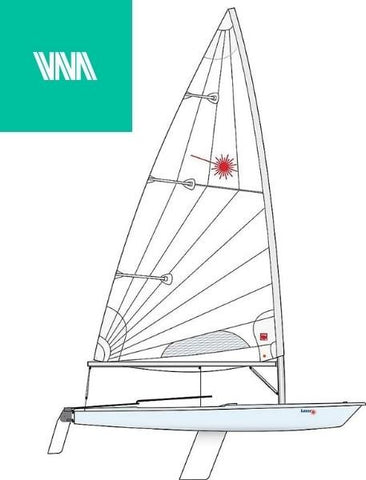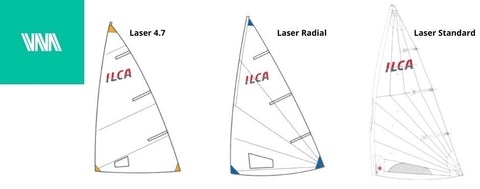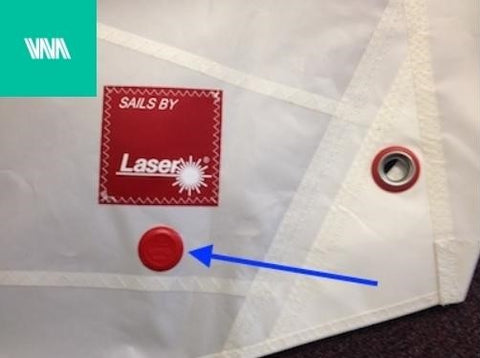Which Laser sail is best for me, and what are they made from?

Which Laser sail is best for me, and what are they made from?
What is a Laser Dinghy?
A laser is a single - handed ILCA dinghy which is 4.2m in length and weighs 56.7kgs. It is one of the most popular single - handed dinghies in the world due to its simplicity and affordability. This class is protected by the strict one-design class rules which ensures no changes are allowed to be made to the boat unless they are specifically mentioned in the class rules. The laser is an Olympic class boat which first made an appearance in Atlanta in 1996. The class ensures the one - design rules allow sailors to excel based on their ability to sail the boat, not the condition of the sails etc. This one design rule means that if a laser hull is maintained the resale value of a laser remains very high.
The laser has a standard hull design with three different types of sails. This allows sailors to progress depending on their ability and weight and height, making it a boat that can be sailed for many many years by all ages. These rigs are known as ILCA 4, ILCA 6, ILCA 7 or otherwise more commonly known as 4.7, radial and standard rig.

Which Laser rig is best suited for me?
The laser has a two part mast, allowing for interchangeable bottom sections as well as a sleeved sail which allows for easy rigging. This is unlike other dinghies which require extensive preparation in relation to rig set up.
The Laser 4.7 (ILCA 4) sail uses a short pre-bent lower section which in turn reduces the sail area by 35% compared to the standard rig. This creates a more balanced helm which compensates for the fact the sailor is lighter than a standard rig helm. This allows helms to learn the basics of sailing as a beginner and also provides sailors with a boat to transition into after smaller dinghies such as an optimist. This rig is ideal for lighter weighted sailors 35-55kg. This is also an ideal rig for a beginner who struggles to control a Laser Radial rig.
The Laser radial (ILCA 6) sail uses a more flexible, slightly shorter lower section compared to the standard rig. The sail area is 18% smaller than the standard making it easy to manoeuvre. The laser radial is by far the most common sail configuration which is used worldwide by over 200,000 sailors across 140 countries making it the most popular youth and single handed dinghy. This rig is used by the Olympic federation as the rig choice for women competing. It is the perfect rig for a 55-70kg sailor.
The Laser standard (ILCA 7) sail and rigging or otherwise known as a ‘full rig’ is ideally set up for heavier weighted people due to the increased sail area. This rig is the preferred choice for men competing in the Olympics. This sail requires a Standard bottom section which differs from the radial bottom section. This rig is suitable for sailors above 60kgs.
How can I tell the difference between the sails by looking at them?
These rigs are clearly identifiable looking at the Laser. The Laser 4.7 has a smaller sail area which is visible at the end of the boom as it is shorter than the other sails. The Laser radial has a blue patch at the clue and tack of the sail. This sail goes to the end of the boom unlike the 4.7 rig. Similarly, the standard rig extends to the end of the boom however, it does not have the blue patches on the sail like the radial.

What is the new Laser Standard Sail design like?
In 2018, a new standard sail was ILCA approved which is referred to as ‘Mark II’ or ‘Mark 2’. There is no difference in size between the Mark I and Mark II however, the Mark 1 has horizontal cut panels compared to the Mark II which has radial cut panels. The Mark II sails also require Mark II battens rather then the Mark I battens. The Laser Class Association was determined to ensure the integrity and quality of the Mark I was not overshadowed by the new Mark II. They did this by creating the Mark II which focuses solely on durability. Therefore, the main difference between the two sails is durability. Clive Humphris, the ILCA Technical Officer is quoted in the class magazine as saying "The main objective of the design project for the Mark II was to create a sail with equal performance to the existing sail, but with better durability. We worked very hard to ensure that the Mark II was not a faster sail and wouldn't make all the existing sails obsolete overnight. The original Laser standard sail will continue to be available through authorized Laser dealers and we fully expect to see the two designs racing side-by-side for a number of years."
The new Mark II sail is made from a heavier cloth from 3.8 to 4.5 dacron material. There has been a change in the reinforcement patches which increases durability and maintains a better sail shape when under pressure. The window is noticeably bigger, as well as improved tapered battens with velcro batten pockets. The mast sleeve has been improved which reduces the amount of creases along the sail. The Laser Class Association successfully created a newer model sail for the Laser Radial without hampering the one design class which focuses on the condition of the boat, not the additional moving parts that can cause a substantial benefit to your racing.
What sail is best suited for me?
There are three types of Laser sails, Official Class Legal Sails, Class Compliant Sails and Training Sails.
Official Class Legal Sails - These sails are class compliant and are required for International and National events. There is a red button on these sails demonstrating that the supplier LaserPerformance has paid a contribution to the Laser class association. This allows them to be considered ILCA approved. These sails have 6 sail numbers on both sides with the first two numbers being red and the latter 4 coloured black.

Class Compliant Sails - These sails are ideal for training camps or non class events. They are a higher standard than a training sail which provides a good basis for training and events with lesser importance. This sail has 6 sail numbers on both sides with the first two numbers being red and the latter 4 coloured black.
Training sails - These sails are made from a thinner material which reflect the cheaper price. They are ideal for sailors that are starting out and need a sail to compete in club races and training. This sail has 6 sail numbers on both sides with the first two numbers being red and the latter 4 coloured black.




Leave a comment